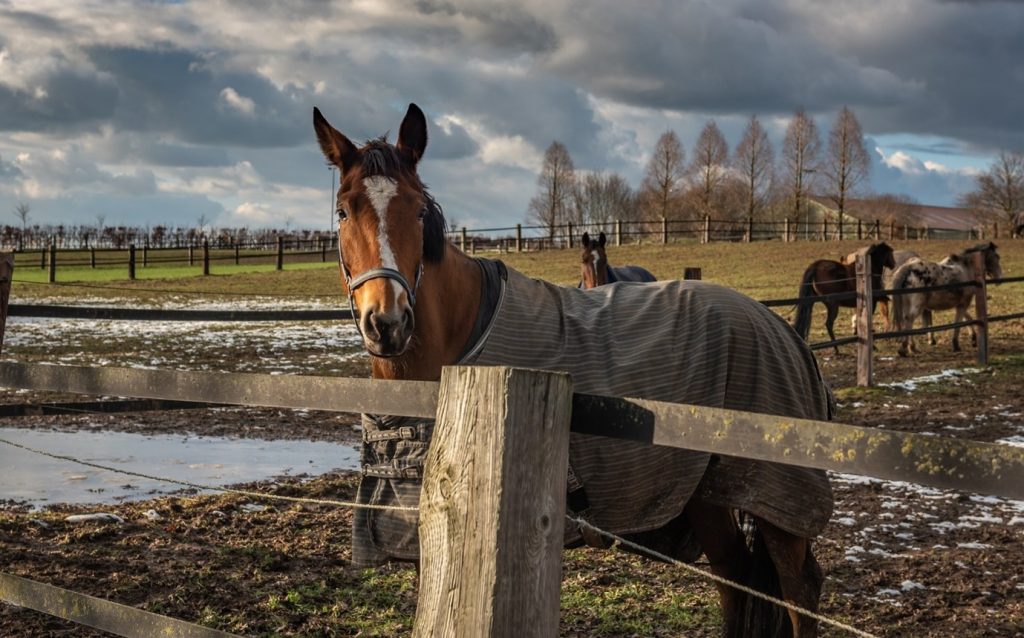
With winter fast approaching, Katie Allen-Clarke, Head of Marketing at Horse & Country is here to offer some top tips on preparing your horse for the colder season. Read on to find out how to keep your four-legged friend cosy, happy and healthy throughout the season.
As the colder weather approaches, we’ll all be thinking about how our horses are going to fair during the winter months. It can be tricky to keep your horse’s weight, immune system and health constant during the colder weather, especially for those who struggle to gain and maintain bodyweight, even in the warmer seasons. But the good news is that there are plenty of things you can do to ensure that your horse is ready for the temperature to drop.
Here, we’ll go through some of the essential tips for preparing your horse for winter. That way, you can start putting things in place and rest assured that you’re ready for the new season.
Plan your winter feeds
During winter, most owners may need to consider increasing their horse’s calorie intake to meet the extra energy requirements for keeping warm in the lower temperatures. This is especially true for those who don’t gain weight easily or are even prone to losing weight.
This is best done by adding extra forage and fibre to their diet. The best way to work out how much you should add to your horse’s feed is through regular condition scoring and consult your vet or a qualified equine nutritionist. Condition scoring your horse will help you assess whether they’re at a healthy weight going into winter, and how close they are to being under or overweight. Underweight horses will need a bit more added to their diet, but you should hold back if your horse is prone to putting on the pounds.
If you’re unsure, your vet or a nutritionist will be able to help you design a feeding routine that works for your horse that will be sustainable throughout the winter months. Horses normally need to eat around 1.5-2% of their bodyweight per day, but if your horse is prone to losing weight this can be increased. It’s useful to start planning your feeding routine now, so that you have plenty of time to tweak it and allow time to get extra hay or other supplies delivered.
Check water sources
It’s always important that horses stay hydrated but during winter, this can be a problem because many water sources that your horse usually drinks from can become frozen. Even if the water doesn’t freeze, if it gets extremely cold then many horses won’t drink it as it feels uncomfortable.
So, at the start of the season you should conduct a check of your water sources to ensure that your horse always has access to drinking water at a reasonable temperature. If you can’t readily heat these areas, pick spots where it will be convenient for you to carry fresh drinking water to each day. Any water sources that your horse doesn’t need direct access to — such as a the tap you use to fill up buckets — can be covered at night to prevent freezing.
For outside water troughs, you can try filling a plastic water bottle with water, adding some salt, and then floating it on the top to prevent or limit freezing – a tennis ball can also work. Water buckets should also be placed within tyres to help insulate them against the cold and lower the temperature of the water slightly. Plus, this will also help prevent them from being accidentally kicked over in the stable.
Decide how to clip your horse
In winter, horses grow a longer coat to help protect themselves from the harsher weather. While this thicker coat is practical for an unridden horse who lives out all year round, if a horse who’s in regular work sweats up a lot under saddle, it may be time for a clip to prevent him from catching a chill, and to help make grooming easier. So, if you’re planning to ride in winter, you should consider how you’re going to clip your horse’s coat.
If your horse will be working fairly hard over winter, then it might be beneficial to partially or wholly clip them, then make up for the lost warmth with a cosy rug when they’re resting. However, if your horse is older or will be resting a lot over the winter months, it’s much better to leave their winter coat unclipped.
You should also start thinking about what kind of rugs your horse will need during the season. For many horses, their own unclipped winter coat will be enough to keep them warm during turnout, but if you are expecting lots of wind, rain and snow they might need some extra help, especially to keep them from getting soaked. Clipped horses will need a thicker rug to compensate for their shorter coat.
Do a shelter check
While you should always be providing shelter for your horses throughout the year, it’s particularly important in winter. During the summer, a shelter’s function is mainly to provide shade for your horses, so you might not have noticed the odd leak in the roof or unsteady plank in the wall. But with the onset of winter weather, these shelters will need to remain dry and windproof. So, conduct a thorough check of any shelters and make sure that everything is sturdy and ready for the coming season. Repair any gaps or leaks now so you’ll be much better prepared once the weather turns. Remember that the run-in shelter should also be big enough for all the horses in the pasture to use at once, as it’s highly likely they will all want to come inside and watch the rain from their cosy corner!
You should also check any other areas that your horse might use for shelter to make sure they’re safe, too. Many horses will shelter under trees and against hay bale blocks, so it’s worth checking that there are no unsteady branches or anything else liable to cause trouble.
Shoe your horse for winter
The ground can be highly changeable during winter and can go from damp and boggy to frozen solid in a matter of days. To make it as easy as possible for your horse’s feet to adjust to the ground, it’s useful to decide on what kind of winter shoeing (or not) to go for. It’s best to consult your farrier to decide what will be best for your horse, but it will depend on a number of factors: the type of ground conditions your horse will be working on, how much work they’ll be doing and the condition of their feet.
Many people choose to only shoe their horse’s front feet during winter if their workload will be reduced, but each horse is different and if you’re going to be riding on the road regularly throughout the colder months, you might also want to consider asking your farrier for road nails. These add extra grip to help provide some extra security for your four-legged friend when the ground is icy.
Preparing your horse for winter involves many different factors, but by using these tips you’ll set yourself and your four-legged friend up to be healthy, happy and comfortable in the colder months.
Article by Katie Allen-Clarke, Head of Marketing at Horse & Country





